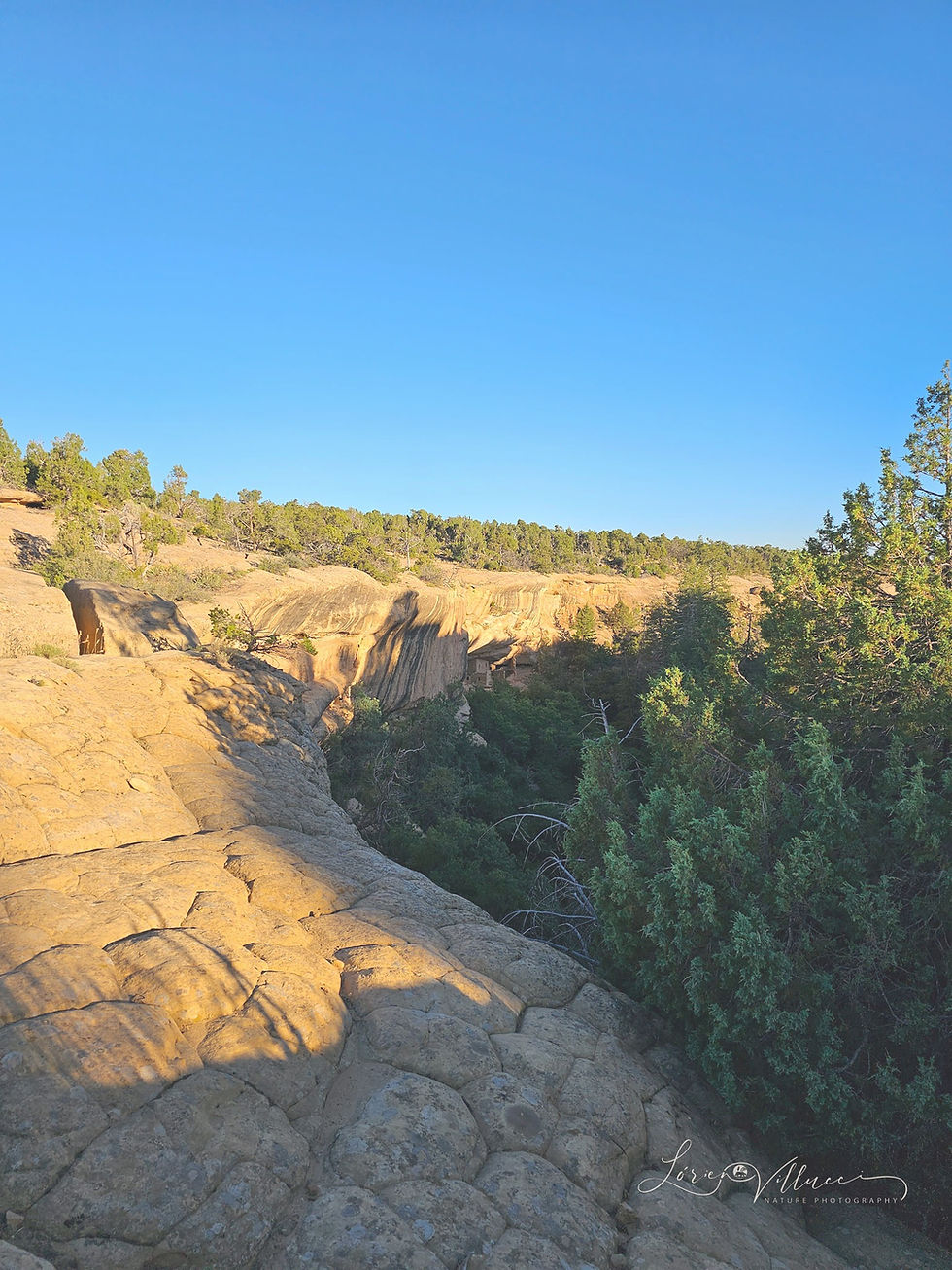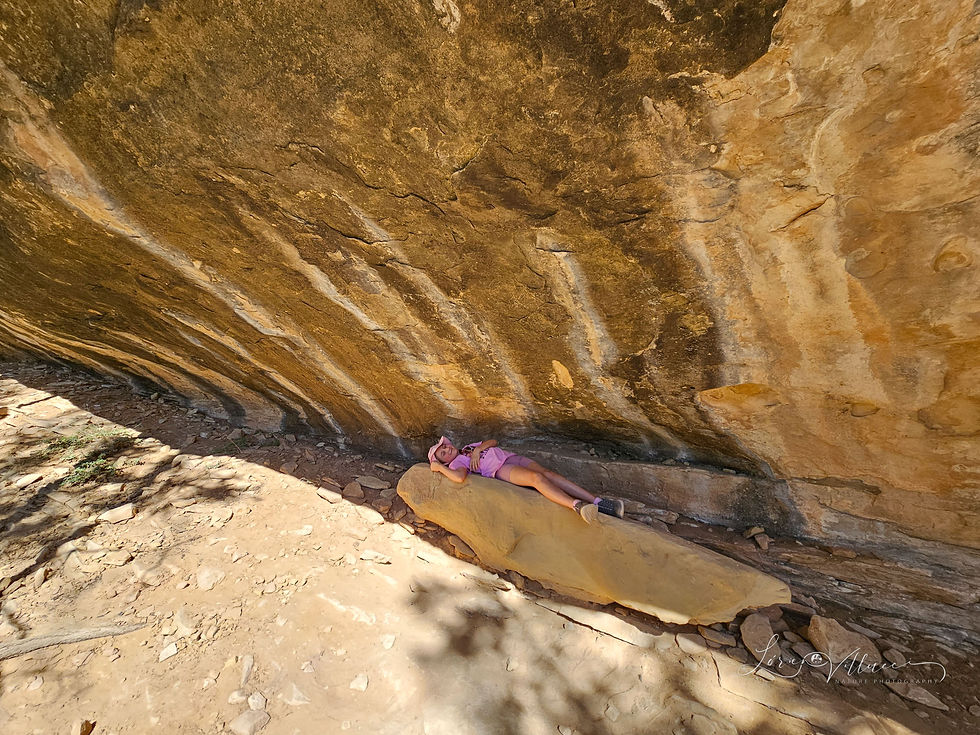Tracing the Footsteps of Ancient Civilizations: Petroglyph Point Trail at Mesa Verde National Park
- Lorien Villucci
- Sep 18, 2023
- 6 min read

Mesa Verde National Park in Cortez, Colorado is a beautiful and fascinating national park that takes you back in time to the days when ancient Pueblo people lived in precarious cliff dwellings perched right on the side of towering and majestic canyons. About 1400 years ago, these ancient people built beautiful sandstone dwellings on the side of the canyon that can best be described as cliff palaces. Archaeologists learned much about the Pueblo people by studying their trash middens next to the dwellings. They were highly skilled at basketry and pottery-making. Examples of their beautiful baskets and black and white pottery can be seen at the Chapin Mesa Archaeological Museum and the Mesa Verde Visitors Center at the entrance to the park. Sometime in the late 1200’s these people moved away from their cliff homes and dispersed across New Mexico and Arizona. No one knows exactly why they moved away, but it’s possible that drought and crop failure caused the exodus from the canyon.

While hiking in Mesa Verde, you can marvel at the incredible canyon views, hike right past ancient cliff dwellings, view a panel of ancient petroglyphs, and see wildlife along the trail. Keep in mind when visiting this park that most of the ancient ruins and hiking trails are at the far end of the park, so stop and enjoy some of the sights along the way. It took us around 40 minutes to drive back to the trails near the ruins from the entrance to the park.

The incredible Petroglyph Point trail begins at the Chapin Mesa Archaeological Museum, which is perched on the edge of magnificent Spruce Canyon. The museum is a great place to start because it will help you understand more about the lives of the ancient Pueblo people who made their elaborate cliff palaces on the edge of the canyons. Before you begin your hike, you must register your name and information in a registry book at the museum or at the start of the trail.

The Petroglyph Point trail will take you past the ancient ruins of Spruce Tree House (currently closed due to rock falls) and on a winding adventure down into the heart of the canyon and then back up. This is a challenging hike with elevation changes and scrambles over stone steps and big boulders, leading to some very memorable and historic sites.

It’s 2.4 miles, but it will feel longer because of the strenuous nature of the climbing involved. It’s narrow, rugged, and quite rocky, so you will definitely get a workout during this moderately challenging to strenuous hike. It took us a little longer than 2 hours to complete it because we stopped to take photos and rest in the shade along the way.


The smell of Spruce, juniper, and pinyon pine fills your senses as you begin the descent into the canyon. The scarlet flowers of Indian paintbrush, yellow wildflowers, and fragrant sage dot the trailside.

Hiking boots are a must on this trail as there are both steep descents and ascents with loose gravel and rocks, as well as cacti with sharp spines. We made this hike during August in the late afternoon, so it was in the low 90’s and extremely hot. We brought water and Gatorade with us, but discovered we really hadn’t brought enough to be comfortable on this longer, more strenuous hike in the heat. We actually ended up purchasing CamelBak water pouches for the entire family after this hike so that we would be hydrated during future hikes.

It’s important to take frequent shade breaks and water breaks on this hike because of the climbing involved and scrambling over large boulders. Keep in mind that you’ll be at 7,000-foot elevation, which can be very difficult when you aren’t used to it. We all struggled to adjust to the high elevation and experienced lightheadedness and difficulty breathing. There is a 174-foot elevation change as you go up the canyon with steep stone steps and boulders. Be aware that the elevation can cause light-headedness and dizziness, so take care as you hike this steep and narrow trail high above the canyon.

As I looked out over the vast canyon, I was amazed at how silent and peaceful it was. I took a video just so I could remember the stillness of it. Every once in a while, the soft song of a small bird would punctuate the silence. I watched ravens wheeling and diving playfully over the vast canyon and marveled at how fearless they are in flight. As I sat on the edge of the canyon, I imagined what it would have been like to live here and I thought of how the ancient Pueblo people walked the same time-worn trails I was exploring now. Be aware that these narrow trails are right over the canyon and the edges can be crumbly. Don’t take selfies near the edge and always use caution by staying away from the cliff edges. You don’t want to be a statistic at a national park!

As we hiked into the cliff overhangs, the rock was so much cooler, and I understood why the ancient people here used these areas as their living spaces and shelters. I imagined what it must have been like to watch a spectacular lightning storm from the safety of the rock overhang.

I also thought about how nerve-wracking it must have been to be a mother watching over her babies and toddlers near the edge of a giant cliff! It’s no wonder that babies were often strapped to mom in a cradleboard or wrap!


We scrambled up into a rock overhang where you could see the ancient remains of a cliff dwelling. We could see the smoke from the fires the people had made to cook their food and stay warm during the frigid winters.


Then we descended down through narrow rock crevices and slotted rock sheets, which our kids thought were lots of fun to squeeze through. Wedging ourselves into the slotted rocks was a relief from the heat. The breeze would blow through the crevices and feel like a blast of air conditioning even in the 93-degree heat! When I pressed my skin against the cool rocks it felt wonderful.

We finally made it down the canyon to a large rock wall about 35 feet wide, covered in ancient petroglyphs. We enjoyed a chance to cool down and take a drink while we studied the panel and all of its designs.

My favorite designs were the handprints, the spirals, and the bighorn sheep.

There were also a number of large carvings that appeared to be deities of some kind. These symbols represent the written language of the ancient Pueblo that lived here.
This is a really interesting spot for children to be able to see over thirty different figures and animals. My youngest really enjoyed spotting the animals on the panel.

It’s very important not to touch or disturb the panel of ancient carvings as the oils and dirt on our hands will stain and destroy the panel. This is one of the most pristine petroglyph panels I’ve ever seen, and fortunately, the thousands of people who have hiked to this spot have respected this historic spot and not defiled it.

After viewing the petroglyph panel, it’s another strenuous climb up the canyon to the rim, using your hands and feet to pull yourself up the stone steps and rocks. I was huffing and puffing as I pulled myself up the canyon! My youngest got discouraged toward the end because she was so hot and tired, but we visualized what would be waiting for her when she got done with the hike. A big glass of chocolate milk! That helped her have something to look forward to.

At the top of the mesa is an easy and level walk through pinyon forest back to the museum. The top of the mesa is where the ancient Pueblo people used to plant their crops known as the” three sisters:" corn, beans, and squash. Today there are fields of wild grasses, wildflowers, pinyon pine, and cacti.


We walked through a beautiful field at golden hour just before sunset, and the grass glowed in the golden light. We passed a tree full of vultures resting as we approached the famous Spruce Tree house ruins.

The Spruce Tree house trail is currently closed due to dangerous rock falls, but in the past, you could climb up into this ancient ruin. Now you can only take photos from a distance across the cliff.

We crossed a large section of slick rock before we got to the other side from the ruin and could take photographs. My daughter enjoyed wondering aloud what it would have been like for the children that lived there and what they did to entertain themselves in this precarious home on the rim of the canyon.

The Petroglyph Point trail is worth all the sweat and strain. It’s not too often that you can find a hike that combines incredible canyon views, ancient ruins, petroglyphs, and wildlife all wrapped into one fantastic and unforgettable experience.

Just don’t forget to bring enough water! Dehydration and altitude sickness are the most common emergencies on hikes at Mesa Verde, so make sure to hydrate and rest in the shade frequently. You’ll have to leave your dogs at home for this hike as dogs aren’t allowed on the trails in Mesa Verde NP.

Happy hiking and don’t forget to send me a comment if you have the opportunity to hike in the footsteps of the ancients on this amazing trail in Colorado!
For more information, visit the Mesa Verde National Park website:

Copyright@LorienVillucciNaturePhotography2023



Comments